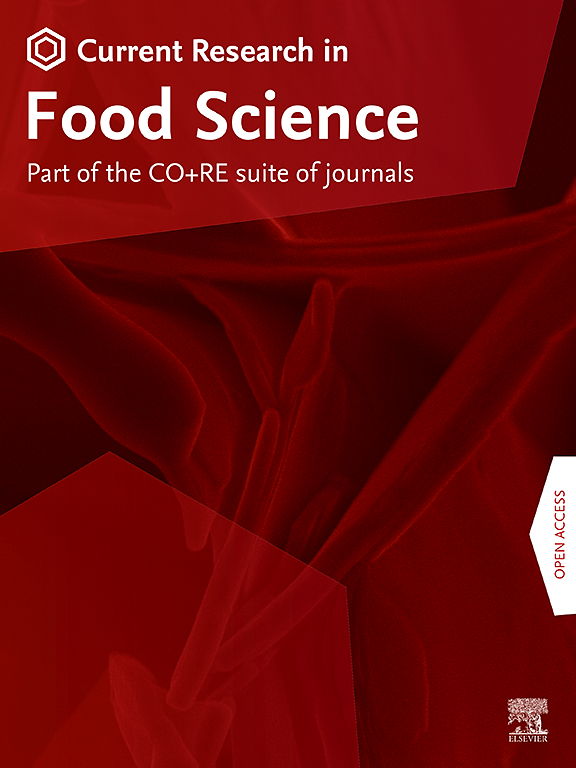Tracing isotopic fingerprints: Unveiling the impact of noodle formulation and cooking water on the isotopic signatures of wheat-derived noodles
IF 6.2
2区 农林科学
Q1 FOOD SCIENCE & TECHNOLOGY
引用次数: 0
Abstract
This study examines how variations in δ2H and δ18O values of cooking water affect the isotopic fingerprint of noodles with different gluten-to-starch formulations, aiming to enhance the current understanding of isotopic changes during food processing and their implications for food authenticity. Eight differently formulated noodles were boiled using waters with six distinct isotopic compositions ranging from of −160‰ to +50‰ for δ2H and from −22.9‰ to +99.9‰ for δ18O, respectively. Linear regression analysis revealed that formulation and water isotopic composition significantly affected the δ2H in cooked noodles (p < 0.05), with model R2 values ranging from 0.66 to 0.94. Additionally, the δ2H values of noodles changed with the isotopic signatures of the cooking water. On the contrary, δ18O in the noodles remained stable despite boiling processing and was also not changing due to the water's isotopic signature. Since consistent effects of formulation and cooking water isotopic signature was observed, an equation for determining the exchange factor (f(H)ex) between noodles and cooking water was developed. The fraction of hydrogen atoms in different noodles for exchange was highest at 19.3% in noodles with the formulation of 45:55(gluten-to-starch) and the lowest at 11.1% in noodles with 100% gluten. The findings prove that cooking water systematically alters the isotopic signatures of noodles, underscoring the necessity of considering this type of effect in food authentication and traceability practices.

追踪同位素指纹:揭示面条配方和烹饪水对小麦衍生面条同位素特征的影响
本研究探讨了烹饪水δ2H和δ18O值的变化如何影响不同面筋-淀粉配方面条的同位素指纹图谱,旨在提高人们对食品加工过程中同位素变化及其对食品真实性的影响的认识。用六种不同同位素组成的水煮8种不同配方的面条,δ2H分别为- 160‰至+50‰,δ18O为- 22.9‰至+99.9‰。线性回归分析表明,配方和水同位素组成对熟面条的δ2H有显著影响(p <;0.05),模型R2值为0.66 ~ 0.94。此外,面条的δ2H值随煮煮水的同位素特征而变化。相反,面条中的δ18O在煮沸过程中保持稳定,也没有因为水的同位素特征而发生变化。由于观察到配方和蒸煮水同位素特征的一致影响,因此建立了确定面条和蒸煮水之间交换因子(f(H)ex)的方程。在面筋比为45:55时,不同面筋中氢原子交换率最高,为19.3%;在面筋比为100%时,氢原子交换率最低,为11.1%。研究结果证明,烹饪水系统性地改变了面条的同位素特征,强调了在食品认证和可追溯性实践中考虑这种影响的必要性。
本文章由计算机程序翻译,如有差异,请以英文原文为准。
求助全文
约1分钟内获得全文
求助全文
来源期刊

Current Research in Food Science
Agricultural and Biological Sciences-Food Science
CiteScore
7.40
自引率
3.20%
发文量
232
审稿时长
84 days
期刊介绍:
Current Research in Food Science is an international peer-reviewed journal dedicated to advancing the breadth of knowledge in the field of food science. It serves as a platform for publishing original research articles and short communications that encompass a wide array of topics, including food chemistry, physics, microbiology, nutrition, nutraceuticals, process and package engineering, materials science, food sustainability, and food security. By covering these diverse areas, the journal aims to provide a comprehensive source of the latest scientific findings and technological advancements that are shaping the future of the food industry. The journal's scope is designed to address the multidisciplinary nature of food science, reflecting its commitment to promoting innovation and ensuring the safety and quality of the food supply.
 求助内容:
求助内容: 应助结果提醒方式:
应助结果提醒方式:


